Experimental Study on the Effect of Date Palm Powder on the Thermal and Physico-Mechanical Properties of Gypsum Mortars
Abstract
:1. Introduction
2. Materials and Methods
2.1. Raw Materials
2.1.1. Gypsum
2.1.2. Date Palm Leaflet Powder (DPLP)
Granulometry
2.2. Experimental Methodology
2.2.1. Preparation of Specimens
2.2.2. Testing procedure
Bulk Density, Porosity, and Water Absorption
Mechanical Characterization
Thermal Conductivity
3. Results and Discussion
3.1. Bulk Density and Porosity
3.2. Water Absorption
3.3. Mechanical Proprieties
3.3.1. Flexural Strength
3.3.2. Compressive Strength
3.4. Thermal Conductivity
4. Conclusions
- An analysis of the size of the granules of DPLP shows that the proportion of particles between 0.5, 1, and 1.5 mm was greater than 85%.
- As the concentration and size of DPLP increases, the absolute and apparent densities proportionally decrease. The decrease in density was directly related to an increase in porosity. These observations reveal a complex relationship between the amount and size of DPLP, providing important insights into the material’s structural characteristics.
- Water absorption notably increases when DPLP is added, primarily occurring at the beginning of testing. This highlights the significant impact of DPLP on the material’s ability to absorb water quickly.
- The mechanical properties of the modified mortars decreased significantly with increasing DPLP concentration and size. This was due to the voids created by the addition of DPLP, making the material more brittle and porous. Thus, the concentration of DPLP and the level of porosity are crucial factors affecting the structural integrity of the material.
- The thermal conductivity was decreased by the increase in the DPLP concentration and size. This suggests that thermal conductivity was inversely proportional to the voids created by the addition of DPLP; indeed, the voids created represent additional thermal resistance, which explains the reduction in thermal conductivity.
Author Contributions
Funding
Institutional Review Board Statement
Informed Consent Statement
Data Availability Statement
Acknowledgments
Conflicts of Interest
References
- Brunello, V.; Bersani, D.; Rampazzi, L.; Sansonetti, A.; Tedeschi, C. Gypsum based mixes for conservation purposes: Evaluation of microstructural and mechanical features. Mater. Constr. 2020, 70, e207. [Google Scholar] [CrossRef]
- Charola, A.E.; Pühringer, J.; Steiger, M. Gypsum: A review of its role in the deterioration of building materials. Environ. Geol. 2007, 52, 207–220. [Google Scholar] [CrossRef]
- Chikhi, M. Young’s modulus and thermophysical performances of bio-sourced materials based on date palm fibers. Energy Build. 2016, 129, 589–597. [Google Scholar] [CrossRef]
- Al-Rifaie, W.N.; Al-Niami, M. Mechanical performance of date palm fibre-reinforced gypsums. Innov. Infrastruct. Solut. 2016, 1, 18. [Google Scholar] [CrossRef]
- Rachedi, M.; Kriker, A. Thermal properties of plaster reinforced with date palm fibers. Civ. Environ. Eng. 2020, 16, 259–266. [Google Scholar] [CrossRef]
- Adamu, M.; Alanazi, F.; Ibrahim, Y.E.; Alanazi, H.; Khed, V.C. A Comprehensive Review on Sustainable Natural Fiber in Cementitious Composites: The Date Palm Fiber Case. Sustainability 2022, 14, 6691. [Google Scholar] [CrossRef]
- Álvarez, M.; Ferrández, D.; Morón, C.; Atanes-Sánchez, E. Characterization of a new lightened gypsum-based material reinforced with fibers. Materials 2021, 14, 1203. [Google Scholar] [CrossRef]
- Amara, I.; Mazioud, A.; Boulaoued, I.; Mhimid, A. Experimental study on thermal properties of bio-composite (gypsum plaster reinforced with palm tree fibers) for building insulation. Int. J. Heat Technol. 2017, 35, 576–584. [Google Scholar] [CrossRef]
- Benaniba, S.; Driss, Z.; Djendel, M.; Raouache, E.; Boubaaya, R. Thermo-mechanical characterization of a bio-composite mortar reinforced with date palm fiber. J. Eng. Fiber. Fabr. 2020, 15, 1558925020948234. [Google Scholar] [CrossRef]
- Ouakarrouch, M.; El, K.; Laaroussi, N.; Garoum, M. Thermal performances and environmental analysis of a new composite building material based on gypsum plaster and chicken feathers waste. Therm. Sci. Eng. Prog. 2020, 19, 100642. [Google Scholar] [CrossRef]
- Almi, K.; Benchabane, A.; Lakel, S.; Kriker, A. Potential utilization of date palm wood as composite reinforcement. J. Reinf. Plast. Compos. 2015, 34, 1231–1240. [Google Scholar] [CrossRef]
- Jonoobi, M.; Shafie, M.; Shirmohammadli, Y.; Ashori, A.; Zarea-Hosseinabadi, H.; Mekonnen, T. A review on date palm tree: Properties, characterization and its potential applications. J. Renew. Mater. 2019, 7, 1055–1075. [Google Scholar] [CrossRef]
- Awad, S.; Zhou, Y.; Katsou, E.; Li, Y.; Fan, M. A Critical Review on Date Palm Tree (Phoenix dactylifera L.) Fibres and Their Uses in Bio-Composites; Springer: The Netherlands, 2020; ISBN 0123456789. [Google Scholar]
- Mohamed, M.; Saba, N.; Alothman, O.Y. Date Palm Fiber Composites; Springer: Singapore, 2020; ISBN 9789811593383. [Google Scholar]
- Bezazi, A.; Amroune, S.; Scarpa, F.; Dufresne, A.; Imad, A. Investigation of the date palm fiber for green composites reinforcement: Quasi-static and fatigue characterization of the fiber. Ind. Crops Prod. 2020, 146, 112135. [Google Scholar] [CrossRef]
- Boumediri, H.; Bezazi, A.; Del Pino, G.G.; Haddad, A.; Scarpa, F.; Dufresne, A. Extraction and characterization of vascular bundle and fiber strand from date palm rachis as potential bio-reinforcement in composite. Carbohydr. Polym. 2019, 222, 114997. [Google Scholar] [CrossRef]
- Scarpa, F.; Amroune, S.; Bezazi, A. Statistical analysis and effect of chemical treatment on the physico-mechanical behavior of fibres from date-palm fruit branches. Synthèse Rev. Sci. Technol. 2015, 31, 108–120. [Google Scholar] [CrossRef]
- Agoudjil, B.; Benchabane, A.; Boudenne, A.; Ibos, L.; Fois, M. Renewable materials to reduce building heat loss: Characterization of date palm wood. Energy Build. 2011, 43, 491–497. [Google Scholar] [CrossRef]
- AL-Oqla, F.M.; Sapuan, S.M. Natural fi ber reinforced polymer composites in industrial applications: Feasibility of date palm fi bers for sustainable automotive industry. J. Clean. Prod. 2014, 66, 347–354. [Google Scholar] [CrossRef]
- Sanjay, M.R.; Madhu, P.; Jawaid, M.; Senthamaraikannan, P.; Senthil, S.; Pradeep, S. Characterization and Properties of Natural Fiber Polymer Composites: A Comprehensive Review; Elsevier: Amsterdam, The Netherlands, 2018; Volume 172, ISBN 9198944711. [Google Scholar]
- Hamza, S.; Saad, H.; Charrier, B.; Ayed, N.; Bouhtoury, F.C. Physico-chemical characterization of Tunisian plant fibers and its utilization as reinforcement for plaster based composites. Ind. Crops Prod. 2013, 49, 357–365. [Google Scholar] [CrossRef]
- Boumhaout, M.; Boukhattem, L.; Hamdi, H.; Benhamou, B. Thermomechanical characterization of a bio-composite building material: Mortar reinforced with date palm fibers mesh. Constr. Build. Mater. 2017, 135, 241–250. [Google Scholar] [CrossRef]
- Chennouf, N.; Agoudjil, B.; Boudenne, A.; Benzarti, K.; Bouras, F. Hygrothermal characterization of a new bio-based construction material: Concrete reinforced with date palm fibers. Constr. Build. Mater. 2018, 192, 348–356. [Google Scholar] [CrossRef]
- Feng, C.; Janssen, H. Impact of water repellent agent concentration on the effect of hydrophobization on building materials. J. Build. Eng. 2021, 39, 102284. [Google Scholar] [CrossRef]
- Kareche, A.; Agoudjil, B.; Haba, B.; Boudenne, A. Study on the Durability of New Construction Materials Based on Mortar Reinforced with Date Palm Fibers Wastes. Waste Biomass Valorization 2020, 11, 3801–3809. [Google Scholar] [CrossRef]
- Bamaga, S.O. A Review on the Utilization of Date Palm Fibers as Inclusion in Concrete and Mortar. Fibers 2022, 10, 35. [Google Scholar] [CrossRef]
- Darwish, E.A.; Mansour, Y.; Elmously, H.; Abdelrahman, A. Development of sustainable building components utilizing date palm midribs for light wide-span multi-purpose structures for rural communities in Egypt. J. Build. Eng. 2019, 24, 100770. [Google Scholar] [CrossRef]
- Asim, M.; Jawaid, M.; Khan, A.; Asiri, A.M.; Malik, M.A. Effects of Date Palm fibres loading on mechanical, and thermal properties of Date Palm reinforced phenolic composites. J. Mater. Res. Technol. 2020, 9, 3614–3621. [Google Scholar] [CrossRef]
- Bamaga, S.O. Physical and mechanical properties of mortars containing date palm fibers. Mater. Res. Express 2022, 9, 015102. [Google Scholar] [CrossRef]
- Chikhi, M.; Agoudjil, B.; Boudenne, A.; Gherabli, A. Experimental investigation of new biocomposite with low cost for thermal insulation. Energy Build. 2013, 66, 267–273. [Google Scholar] [CrossRef]
- Ali, M.; Alabdulkarem, A.; Nuhait, A.; Al-Salem, K.; Iannace, G.; Almuzaiqer, R. Characteristics of Agro Waste Fibers as New Thermal Insulation and Sound Absorbing Materials: Hybrid of Date Palm Tree Leaves and Wheat Straw Fibers. J. Nat. Fibers 2022, 19, 6576–6594. [Google Scholar] [CrossRef]
- Khoudja, D.; Taallah, B.; Izemmouren, O.; Aggoun, S.; Herihiri, O.; Guettala, A. Mechanical and thermophysical properties of raw earth bricks incorporating date palm waste. Constr. Build. Mater. 2021, 270, 121824. [Google Scholar] [CrossRef]
- Alothman, O.Y.; Jawaid, M.; Senthilkumar, K.; Chandrasekar, M.; Alshammari, B.A.; Fouad, H.; Hashem, M.; Siengchin, S. Thermal characterization of date palm/epoxy composites with fillers from different parts of the tree. J. Mater. Res. Technol. 2020, 9, 15537–15546. [Google Scholar] [CrossRef]
- Gounni, A.; Mabrouk, M.T.; El Wazna, M.; Kheiri, A.; El Alami, M.; El Bouari, A.; Cherkaoui, O. Thermal and economic evaluation of new insulation materials for building envelope based on textile waste. Appl. Therm. Eng. 2019, 149, 475–483. [Google Scholar] [CrossRef]
- Hachaichi, A.; Kouini, B.; Kian, L.K.; Asim, M.; Jawaid, M. Extraction and Characterization of Microcrystalline Cellulose from Date Palm Fibers using Successive Chemical Treatments. J. Polym. Environ. 2021, 29, 1990–1999. [Google Scholar] [CrossRef]
- Kethiri, M.A.; Chikhi, M.; Tedeschi, C.; Belghar, N. The Characterization of the Date Palm Tree Leaflet for Using That as Green Materials for Building House. Mater. Circ. Econ. 2022, 4, 16. [Google Scholar] [CrossRef]
- NF P18-560. NF P18-560: Aggregates-Particle Size Distribution by Sieving. 1990. Available online: https://www.boutique.afnor.org/en-gb/standard/p18560/aggregates-particle-size-distribution-by-sieving/fa020820/56248 (accessed on 27 May 2023).
- Alatshan, F.; Altlomate, A.M.; Mashiri, F.; Alamin, W. Effect of date palm fibers on the mechanical properties of concrete. Int. J. Sustain. Build. Technol. Urban Dev. 2017, 8, 37–41. [Google Scholar]
- Alwared, A.I.; Al-hubboubi, S.K.A.; Dawood, D.S. Effect of Date Palm Leaf Fiber on Mechanical Properties of Concrete. Assoc. Arab. Univ. J. Eng. Sci. 2016, 23, 49–66. [Google Scholar]
- Braiek, A.; Karkri, M.; Adili, A.; Ibos, L.; Ben Nasrallah, S. Estimation of the thermophysical properties of date palm fibers/gypsum composite for use as insulating materials in building. Energy Build. 2017, 140, 268–279. [Google Scholar] [CrossRef]
- ASTM C1396/C1396M-17; Standard Specification for Gypsum Board. ASTM International: West Conshohocken, PA, USA, 2017; Volume 10, pp. 1–5. [CrossRef]
- ASTM C29/C29M; Standard Test Method for Bulk Density (‘Unit Weight’) and Voids in Aggregate. ASTM International: West Conshohocken, PA, USA, 2010.
- ASTM C127-88; Standard Test Method for Density, Relative Density (Specific Gravity), and Absorption of Coarse Aggregate. ASTM International: West Conshohocken, PA, USA, 1988. [CrossRef]
- ASTM C642-13; Standard Test Method for Density, Absorption, and Voids in Hardened Concrete. ASTM International: West Conshohocken, PA, USA, 2013. Available online: https://www.astm.org/Standards/C642.htm (accessed on 27 May 2023).
- ASTM D790; Standard Test Methods for Flexural Properties of Unreinforced and Reinforced Plastics and Electrical Insulating Materials. ASTM International: West Conshohocken, PA, USA, 2017.
- ASTM C109/C109M-20; Standard Test Method for Compressive Strength of Hydraulic Cement Mortars (Using 2-in. or [50-mm] Cube Specimens). ASTM International: West Conshohocken, PA, USA, 2020.
- ASTM C518-21; Standard Test Method for Steady-State Thermal Transmission Properties by Means of the Heat Flow Meter Apparatus. ASTM International: West Conshohocken, PA, USA, 2021.
- Barreca, F.; Praticò, P. Assessment of passive retrofitting strategies to improve the thermal performance of extra-virgin olive oil storage area in traditional rural olive mills. Sustainability 2020, 12, 194. [Google Scholar] [CrossRef]
- Belkharchouche, D.; Chaker, A. Effects of moisture on thermal conductivity of the lightened construction material. Int. J. Hydrogen Energy 2016, 41, 7119–7125. [Google Scholar] [CrossRef]
- Djoudi, A.; Khenfer, M.M.; Bali, A.; Kadri, E.H.; Debicki, G. Performance of date palm fibres reinforced plaster concrete. Int. J. Phys. Sci. 2012, 7, 2845–2853. [Google Scholar] [CrossRef]
- Aamr-Daya, E.; Langlet, T.; Benazzouk, A.; Quéneudec, M. Feasibility study of lightweight cement composite containing flax by-product particles: Physico-mechanical properties. Cem. Concr. Compos. 2008, 30, 957–963. [Google Scholar] [CrossRef]
- Hakamy, A.; Shaikh, F.; Low, I.M. Microstructures and mechanical properties of hemp fabric reinforced organoclay-cement nanocomposites. Constr. Build. Mater. 2013, 49, 298–307. [Google Scholar] [CrossRef]
- Celiktas, M.S.; Uyan, M. Plant Fiber Reinforced Biocomposite: Properties And Applications. Mugla J. Sci. Technol. 2019, 5, 42–48. [Google Scholar] [CrossRef]
- Pirman, F.; Awang, A. Enhanced Mechanical Properties Plaster of Paris with Addition of Rice Husk Fibers. In IOP Conference Series: Earth and Environmental Science; IOP Publishing: Bristol, UK, 2022; Volume 1103. [Google Scholar] [CrossRef]
- Yaya, A.; Daafuor, J.; Bowen-dodoo, E.; Nyankson, E. Mechanical and statistical analysis of polypropylene composites derived from mixed clay-oil palm fruit particles. ARPN J. Eng. Appl. Sci. 2018, 13, 8599–8606. [Google Scholar]
- Sakthieswaran, N.; Sophia, M. Environmental Technology & Innovation Prosopis juliflora fibre reinforced green building plaster materials—An eco-friendly weed control technique by effective utilization. Environ. Technol. Innov. 2020, 20, 101158. [Google Scholar] [CrossRef]
- Kittikorn, T.; Strömberg, E.; Ek, M.; Karlsson, S. Comparison of water uptake as function of surface modification of empty fruit bunch oil palm fibres in PP biocomposites. BioResources 2013, 8, 2998–3016. [Google Scholar] [CrossRef]
- Liu, J.; Lv, C. Research Progress on Durability of Cellulose Fiber-Reinforced Cement-Based Composites. Int. J. Polym. Sci. 2021, 2021, 1014531. [Google Scholar] [CrossRef]
- Stevulova, N.; Vaclavik, V.; Hospodarova, V.; Dvorský, T. Recycled cellulose fiber reinforced plaster. Materials 2021, 14, 2986. [Google Scholar] [CrossRef] [PubMed]
- Mohanty, A.K.; Misra, M.; Dreal, L.T. Surface modifications of natural fibres and peformance of the resulting biocomposite. Compos. Interfaces 2001, 8, 313–343. [Google Scholar] [CrossRef]
- Sair, S.; Mandili, B.; Taqi, M.; Elbouari, A. Development of a new eco-friendly composite material based on gypsum reinforced with a mixture of cork fibre and cardboard waste for building thermal insulation. Compos. Commun. 2019, 16, 20–24. [Google Scholar] [CrossRef]
- Khedari, J.; Suttisonk, B.; Pratinthong, N.; Hirunlabh, J. New lightweight composite construction materials with low thermal conductivity. Cem. Concr. Compos. 2001, 23, 65–70. [Google Scholar] [CrossRef]
- Mohammed, M.; Rasidi, M.S.M.; Mohammed, A.M.; Rahman, R.; Osman, A.F.; Adam, T.; Betar, B.O.; Dahham, O.S. Interfacial Bonding Mechanisms of Natural Fibre-Matrix Composites: An Overview. BioResources 2022, 17, 7031–7090. [Google Scholar] [CrossRef]
- Migneault, S.; Koubaa, A.; Erchiqui, F.; Chaala, A.; Englund, K.; Wolcott, M.P. Effects of processing method and fiber size on the structure and properties of wood-plastic composites. Compos. Part A Appl. Sci. Manuf. 2009, 40, 80–85. [Google Scholar] [CrossRef]
- Torres-Rendón, J.G.; Valdez-Fausto, M.E.; Anzaldo-Hernández, J.; Jiménez-Amezcua, R.M.; Satyanarayana, K.G.; García-Enriquez, S.; Lomelí-Ramírez, M.G. Preparation and characterization of nanocomposites based on linear medium density polyethylene/cellulose nanofibers from Agave tequilana Bagasse Waste. BioResources 2019, 14, 9806–9825. [Google Scholar] [CrossRef]
- Benaimeche, O.; Carpinteri, A.; Mellas, M.; Ronchei, C.; Scorza, D.; Vantadori, S. The influence of date palm mesh fi bre reinforcement on flexural and fracture behaviour of a cement-based mortar. Compos. Part B 2018, 152, 292–299. [Google Scholar] [CrossRef]
- Abu-Jdayil, B.; Mourad, A.H.I.; Hussain, A.; Al Abdallah, H. Thermal insulation and mechanical characteristics of polyester filled with date seed wastes. Constr. Build. Mater. 2022, 315, 125805. [Google Scholar] [CrossRef]
- Belakroum, R.; Gherfi, A.; Kadja, M.; Maalouf, C.; Lachi, M.; El Wakil, N.; Mai, T.H. Design and properties of a new sustainable construction material based on date palm fibers and lime. Constr. Build. Mater. 2018, 184, 330–343. [Google Scholar] [CrossRef]
- Bouzit, S.; Laasri, S.; Taha, M.; Laghzizil, A.; Hajjaji, A.; Merli, F.; Buratti, C. Characterization of natural gypsum materials and their composites for building applications. Appl. Sci. 2019, 9, 2443. [Google Scholar] [CrossRef]
- Dieye, Y.; Toure, P.M.; Bodian, S.; Gueye, P.M.; Faye, M.; Sabourin, V. Study of thermal and mechanical properties of typha leaf-clay panels. J. Sustain. Constr. Mater. Technol. 2021, 6, 135–142. [Google Scholar] [CrossRef]
- Sawadogo, M.; Duquesne, M.; Belarbi, R.; Hamami, A.E.A.; Godin, A. Review on the integration of phase change materials in building envelopes for passive latent heat storage. Appl. Sci. 2021, 11, 9305. [Google Scholar] [CrossRef]
- Shahedan, N.F.; Abdullah, M.M.A.B.; Mahmed, N.; Kusbiantoro, A.; Tammas-Williams, S.; Li, L.Y.; Aziz, I.H.; Vizureanu, P.; Wysłocki, J.J.; Błoch, K.; et al. Properties of a new insulation material glass bubble in geo-polymer concrete. Materials 2021, 14, 809. [Google Scholar] [CrossRef]
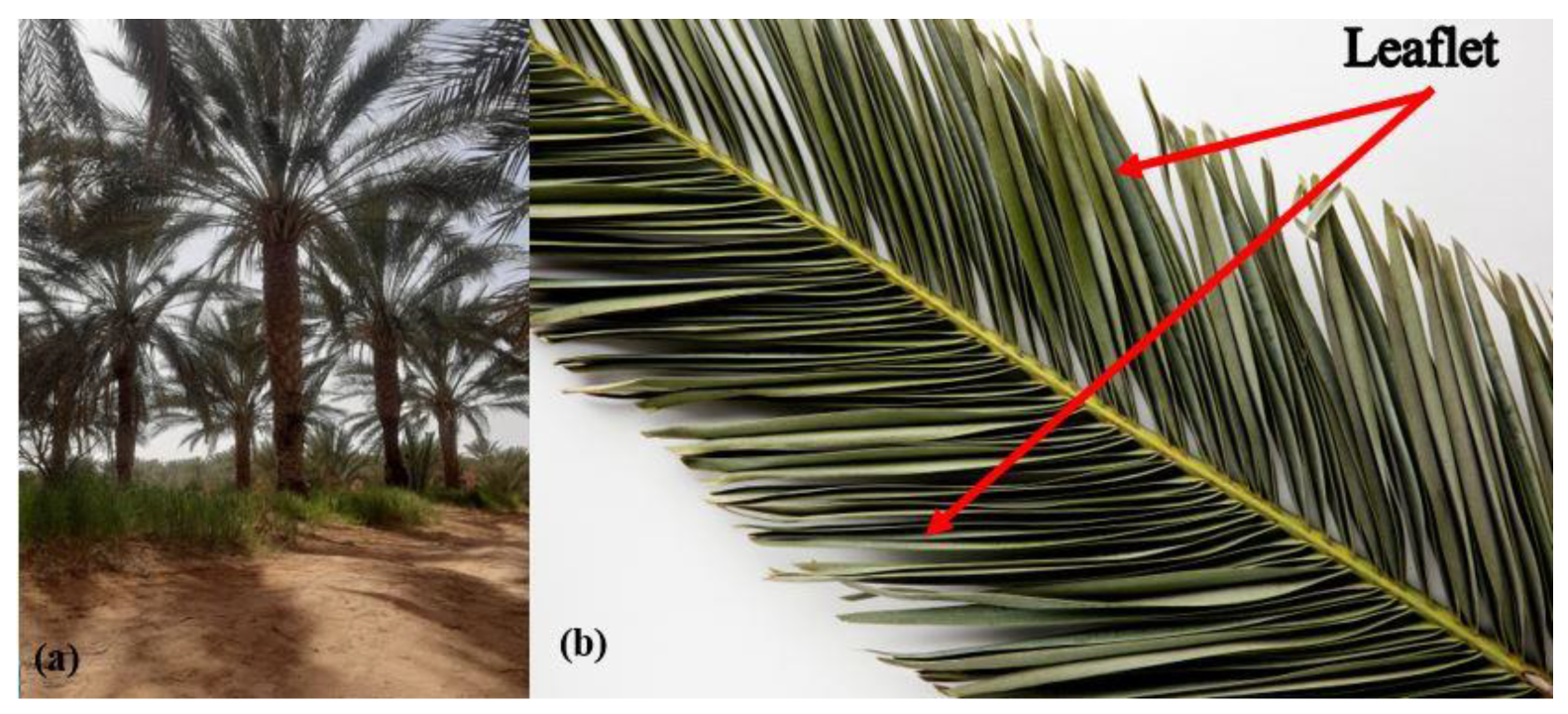

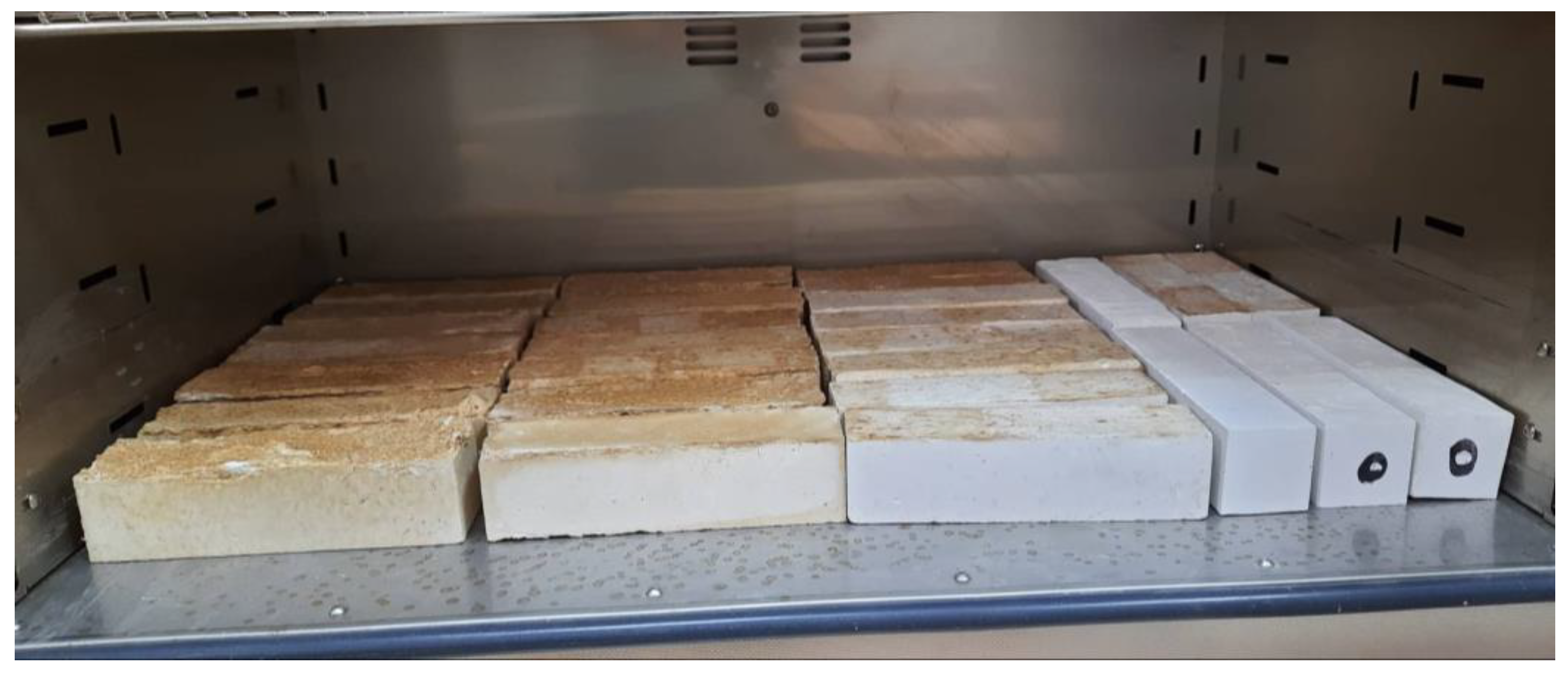

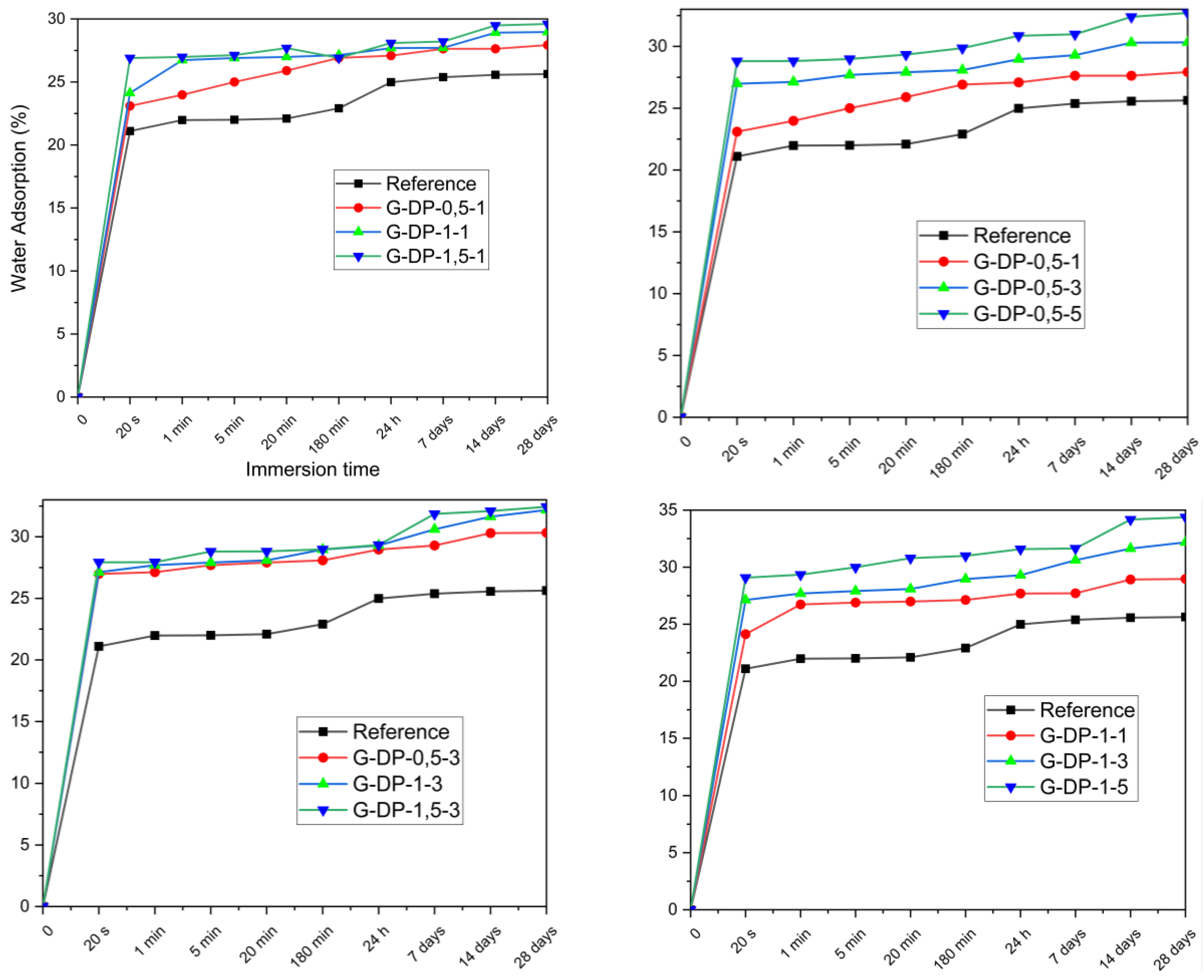
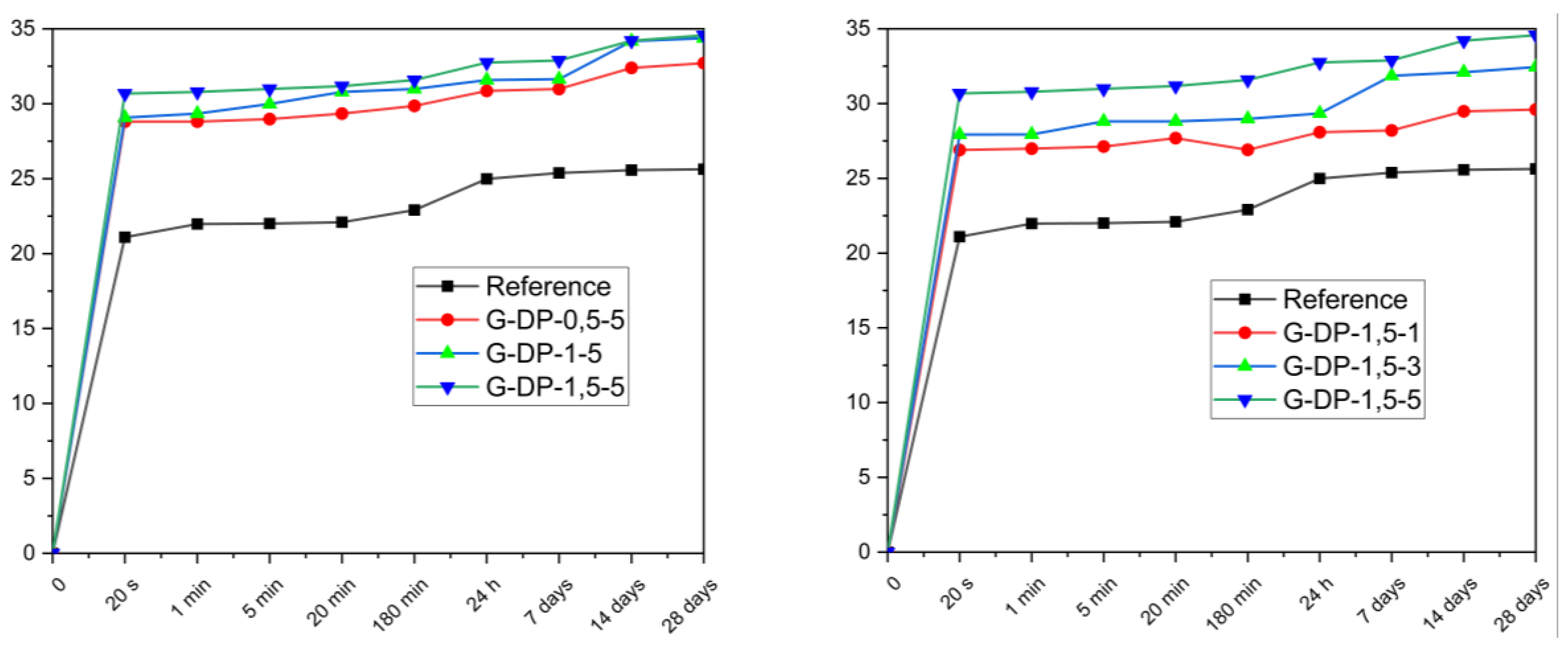

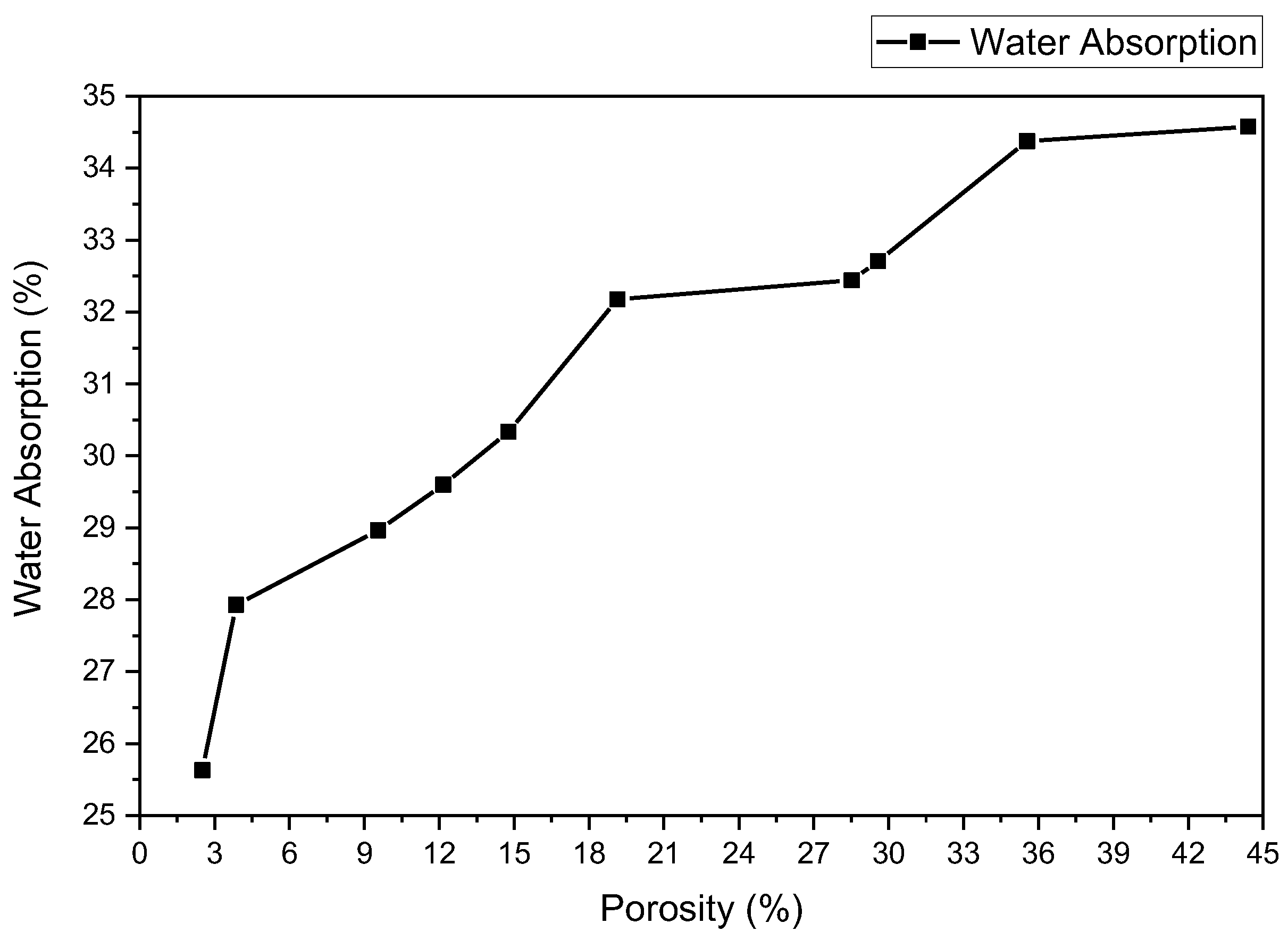

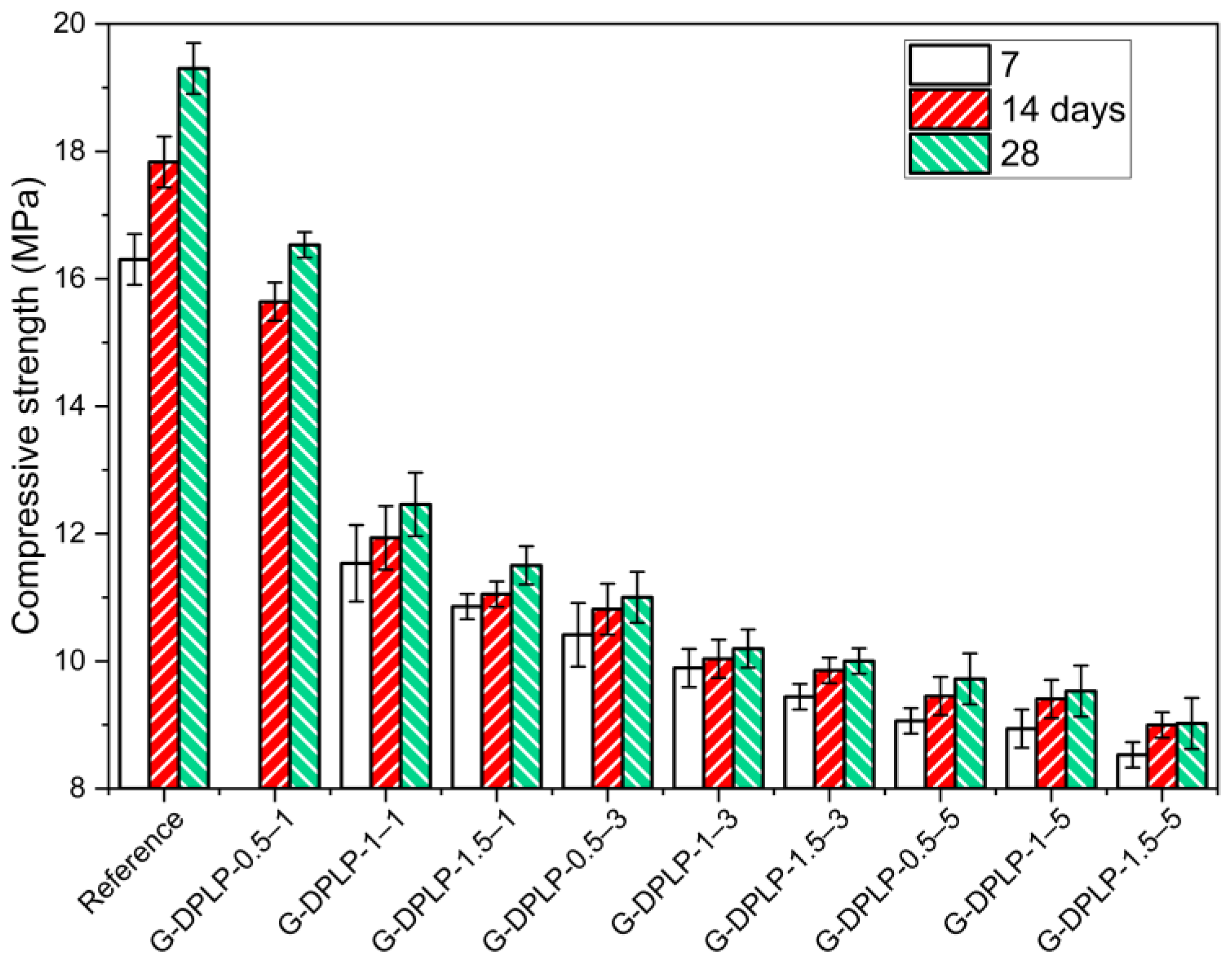


| Constituents | SO2 | CaO | SiO2 | MgO | AL2O3 | Na2O | Fe2O3 |
|---|---|---|---|---|---|---|---|
| Percentage % | 45.63 | 32.12 | 0.58 | 0.41 | 0.12 | 0.09 | 0.08 |
| Concentration (wt. %) Y | Dimension (mm) X | Names |
|---|---|---|
| 0 | / | Reference |
| 1 | 0.5 | G-DPLP-0.5–1 |
| 1 | G-DPLP-1–1 | |
| 1.5 | G-DPLP-1.5–1 | |
| 3 | 0.5 | G-DPLP-0.5–3 |
| 1 | G-DPLP-1–3 | |
| 1.5 | G-DPLP-1.5–3 | |
| 5 | 0.5 | G-DPLP-0.5–5 |
| 1 | G-DPLP-1–5 | |
| 1.5 | G-DPLP-1.5–5 |
| Present Work | Literature | ||||
|---|---|---|---|---|---|
| Abs (kg/m3) | App (kg/m3) | P (%) | Bulk Density (kg/m3) | References | |
| G-Pure (0%) | 1279.04 | 1275.83 | 0.25 | 1240 | [5] |
| G-DPLP-0.5–1 | 1244.79 | 1240 | 0.38 | 1180 | [4] |
| G-DPLP-1–1 | 1243.90 | 1232,14 | 0.94 | ||
| G-DPLP-1.5–1 | 1224.71 | 1210 | 1.21 | ||
| G-DPLP-0.5–3 | 1207.93 | 1190.35 | 1.45 | 1100 | |
| G-DPLP-1–3 | 1184.89 | 1162.64 | 1.87 | ||
| G-DPLP-1.5–3 | 1182.29 | 1149.5 | 2.77 | ||
| G-DPLP-0.5–5 | 1184.87 | 1150.83 | 2.87 | 1000 | |
| G-DPLP-1–5 | 1161.45 | 1121.59 | 3.43 | ||
| G-DPLP-1.5–5 | 1160.15 | 1110.83 | 4.25 | ||
Disclaimer/Publisher’s Note: The statements, opinions and data contained in all publications are solely those of the individual author(s) and contributor(s) and not of MDPI and/or the editor(s). MDPI and/or the editor(s) disclaim responsibility for any injury to people or property resulting from any ideas, methods, instructions or products referred to in the content. |
© 2024 by the authors. Licensee MDPI, Basel, Switzerland. This article is an open access article distributed under the terms and conditions of the Creative Commons Attribution (CC BY) license (https://creativecommons.org/licenses/by/4.0/).
Share and Cite
Kethiri, M.A.; Belghar, N.; Chikhi, M.; Boutera, Y.; Beldjani, C.; Tedeschi, C. Experimental Study on the Effect of Date Palm Powder on the Thermal and Physico-Mechanical Properties of Gypsum Mortars. Sustainability 2024, 16, 3015. https://doi.org/10.3390/su16073015
Kethiri MA, Belghar N, Chikhi M, Boutera Y, Beldjani C, Tedeschi C. Experimental Study on the Effect of Date Palm Powder on the Thermal and Physico-Mechanical Properties of Gypsum Mortars. Sustainability. 2024; 16(7):3015. https://doi.org/10.3390/su16073015
Chicago/Turabian StyleKethiri, Mohamed Aymen, Noureddine Belghar, Mourad Chikhi, Yousra Boutera, Charafeddine Beldjani, and Cristina Tedeschi. 2024. "Experimental Study on the Effect of Date Palm Powder on the Thermal and Physico-Mechanical Properties of Gypsum Mortars" Sustainability 16, no. 7: 3015. https://doi.org/10.3390/su16073015





